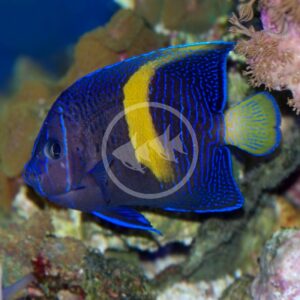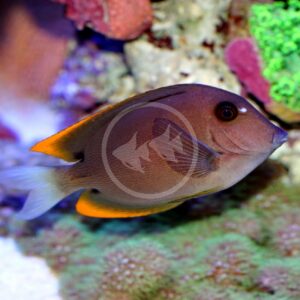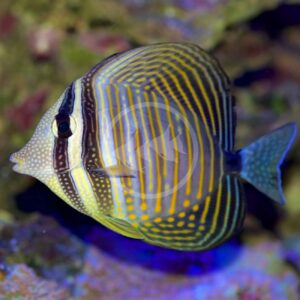
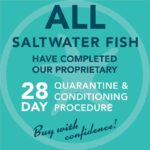
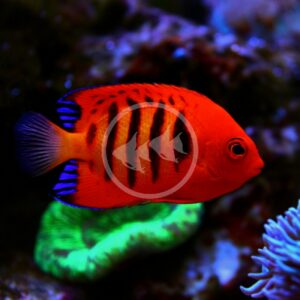
ANGEL – LAMARCK Genicanthus lamarck
$99.99 – $299.99
The Lamarck’s Angelfish (or Lamark Angelfish) is also sometimes called the Freckletail Lyretail Angelfish. Native to the Indo-West-Pacific region ranging from the Gulf of Thailand east through the Malayan Archipelago to the Solomon Islands, north as far as southern Japan and south to the Great Barrier Reef. Its Australian distribution also includes Ashmore Reef and Cartier Island in the Timor Sea. They have the distinction among angelfish of being sexually dimorphic. Both males and females are a silvery-gray with horizontal black lines from head to tail. The female’s stripes are bolder with one extending into the length of the caudal fin. In both, the long dorsal fin is black, although larger in the female, and the caudal fin is freckled with black. Females tend to be smaller, but this species can reach a length of up to 8 inches.
Care Level: Moderate
Temperament: Peaceful
Reef Compatible: Yes
General Description: The Lamarck’s Angelfish, also referred to as simply the Lamark Angelfish, has a wide distribution across the Indo-West-Pacific. Genicanthus have the distinction among angelfish of being sexually dimorphic. Both males and females have silvery-gray bodies with horizontal black lines from head to tail. The female’s stripes are bolder, with one extending into the length of the caudal fin. In both, the long dorsal fin is black, although larger in the female, and the caudal fin is freckled with black. Genicanthus are the only true “reef safe” angelfish in the hobby because their diets are predominately made up of zooplankton rather than corals. This angelfish can be kept as a male-female pair, or a male with several females. While females tend to stay smaller, a Lamarck’s angel can reach a size of approximately 8″.
Diet Requirements: In the wild Genicanthus angelfish are zooplanktivores. While this specific food source can be a challenge to replicate in the home aquarium, the Lamarck’s angel will accept a wide variety of prepared foods. Offer a varied diet of high quality algae, pellets, flakes, and especially enriched frozen foods such as spirulina brine shrimp, mysis shrimp, calanus and angel specific mixes for best coloration, immune function and optimal health.
Care Requirements: A minimum 125 gallon aquarium with 12+ inch width is ideal for a single, large Lamarck’s angel or a smaller pair. The aquarium will need to be upgraded accordingly for more individuals. Genicanthus angelfish are intolerable of nitrite or ammonia spikes. This angelfish enjoys some rock work and crevices to take refuge, but should be provided with ample open swimming space. The Lamarck’s angel is rather non-confrontational with most tank-mates, including angelfish in other genera (Pomacanthus, Holocanthus, Centropyge). Compatability with other species within Genicanthus is variable; do not house more than one male in the same aquarium. The Lamarck’s angel has been observed to occasionally chase smaller, more docile planktivores such as anthias. Recommended water conditions, 72-78° F, KH 8-12, pH 8.1-8.4, salinity 1.020-1.025.
Purchase Size: Small: 2-1/2″ or less; Medium: 2-3/4″ to 3-3/4″; Large: 4″ to 5-1/2″;
Note: Your item may not look identical to the image provided due to variation within species. Purchase size is approximate.
Dry goods orders are shipped via US Postal Service or UPS to the address provided at checkout based on the selection made in your website shopping cart. Product is carefully packed to help prevent any damage during shipping. Once processed you will receive a shipment notification via email with tracking number, and delivery notification. Please allow 48 hours for processing after your order is placed.
Perishable items (i.e. live plants, refrigerated/frozen foods) are shipped via US Postal Service 2-3 day to the address provided at checkout for a $25.00 flat rate charge. Items are packed with secure packing material and heat, cold, or Cryo packs as needed to maintain safe temperatures during transit. If one or more perishable items are in the shopping cart at checkout the $25.00 perishable shipping charge will automatically appear and need to be selected. Once processed you will receive a shipment notification via email with tracking number. Please allow 48 hours for processing after your order is placed.
Livestock (i.e. fish, invertebrates, coral) are shipped via UPS Overnight to the address provided at checkout for a $55.00 flat rate charge. Livestock is packed in insulated styrofoam boxes with secure packing material and heat, cold, or Cryo packs as needed to maintain safe temperatures during transit. If one or more livestock items are in the shopping cart at checkout the $55.00 livestock shipping charge will automatically appear and need to be selected. Livestock is shipped Monday through Wednesday ONLY (no weekend delivery is available) weather permitting, and we reserve the right to delay shipping until conditions are appropriate for safe arrival. Once your order is placed we will contact you to arrange the best shipping date based on these criteria. Someone must be available to receive the livestock order on the first delivery attempt. Once processed you will receive a shipment notification via email with tracking number. Please allow 48 hours for processing after your order is placed.
For mixed dry goods/perishable & livestock orders items will be shipped via their corresponding shipping methods outlined above. Dry goods will be shipped via US Postal Service or UPS based on your selection and checkout, while livestock will ship via UPS Overnight for a $55.00 flat rate charge. You will receive separate notifications and tracking numbers for the dry goods and livestock. Please note due to different carriers and shipping methods dry goods and livestock may arrive on different days.
Related products
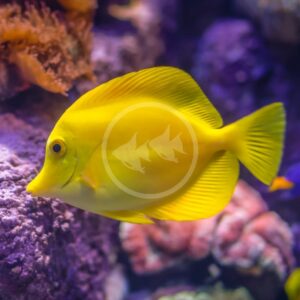

TANG – YELLOW Zebrasoma flavescens
$174.99 – $399.99
CICHLID – RAM GERMAN GOLD
Mikrogeophagus ramirezi
$5.99 – $16.99
TANG – TOMINIENSIS Ctenochaetus tominiensis
$119.99 – $169.99

BUTTERFLY – HENIOCHUS BLACK & WHITE Heniochus acuminata
$119.99 – $249.99TANG – SAILFIN DESJARDINII Zebrasoma desjardinii
$169.99 – $199.99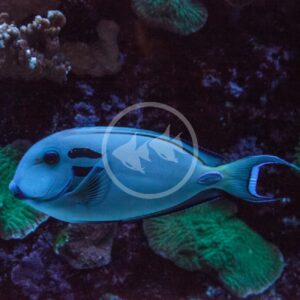

TANG – LIEUTENANT Acanthurus tennenti
$139.99 – $209.99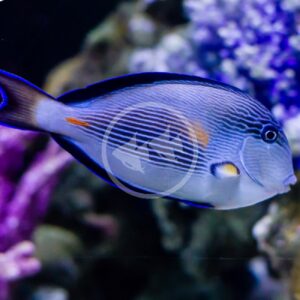

TANG – SOHAL Acanthurus sohal
$289.99 – $319.99